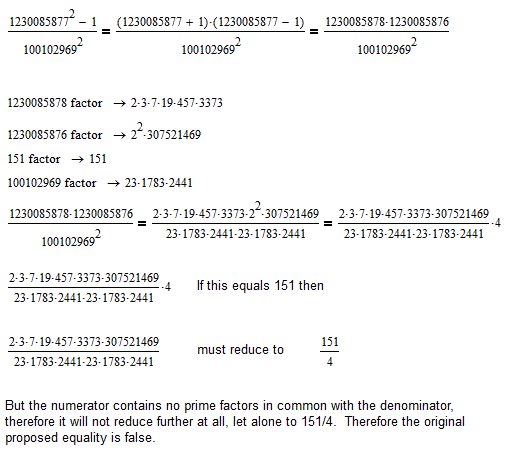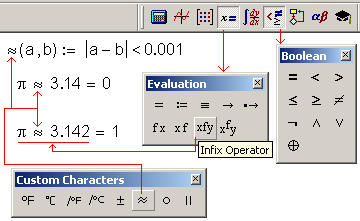Community Tip - Learn all about PTC Community Badges. Engage with PTC and see how many you can earn! X
- Subscribe to RSS Feed
- Mark Topic as New
- Mark Topic as Read
- Float this Topic for Current User
- Bookmark
- Subscribe
- Mute
- Printer Friendly Page
TRUE OR FALSE with this calculation ?
- Mark as New
- Bookmark
- Subscribe
- Mute
- Subscribe to RSS Feed
- Permalink
- Notify Moderator
TRUE OR FALSE with this calculation ?
Hello all,
I really don't know that TRUE OR FALSE with this calculation ? Attach File below.
Regard,
Loi.
Solved! Go to Solution.
- Labels:
-
Other
Accepted Solutions
- Mark as New
- Bookmark
- Subscribe
- Mute
- Subscribe to RSS Feed
- Permalink
- Notify Moderator
The answer is FALSE. Even Mathcad 11's symbolic processor shows:  The same result comes from Mathcad 14's symbolic processor, which is from a different source, i.e., MuPad vs. Maple.
The same result comes from Mathcad 14's symbolic processor, which is from a different source, i.e., MuPad vs. Maple.
So, Mathcad's numeric processor, which is limited in its numerical precision winds up truncating the answer. The symbolic processor's floating point answer is

which, with careful digit counting shows that the numeric processor of almost any calculator and any normal spreadsheet program will truncate the answer to 151, but it's not. You may wish to find some aribtrary precision calculators, some of which can be downloaded from the web, to verify the results. Prime factorization in Mathcad shows the ratio to be composed of products of different primes.
- Mark as New
- Bookmark
- Subscribe
- Mute
- Subscribe to RSS Feed
- Permalink
- Notify Moderator
Mathcad says it's true.
- Mark as New
- Bookmark
- Subscribe
- Mute
- Subscribe to RSS Feed
- Permalink
- Notify Moderator
Mathcad also says:
Alan
- Mark as New
- Bookmark
- Subscribe
- Mute
- Subscribe to RSS Feed
- Permalink
- Notify Moderator
- Mark as New
- Bookmark
- Subscribe
- Mute
- Subscribe to RSS Feed
- Permalink
- Notify Moderator
- Mark as New
- Bookmark
- Subscribe
- Mute
- Subscribe to RSS Feed
- Permalink
- Notify Moderator
The Maple kernel in MC11 also shows
The numeric calculation is wrong because of roundoff errors.
- Mark as New
- Bookmark
- Subscribe
- Mute
- Subscribe to RSS Feed
- Permalink
- Notify Moderator
The answer is FALSE. Even Mathcad 11's symbolic processor shows:  The same result comes from Mathcad 14's symbolic processor, which is from a different source, i.e., MuPad vs. Maple.
The same result comes from Mathcad 14's symbolic processor, which is from a different source, i.e., MuPad vs. Maple.
So, Mathcad's numeric processor, which is limited in its numerical precision winds up truncating the answer. The symbolic processor's floating point answer is

which, with careful digit counting shows that the numeric processor of almost any calculator and any normal spreadsheet program will truncate the answer to 151, but it's not. You may wish to find some aribtrary precision calculators, some of which can be downloaded from the web, to verify the results. Prime factorization in Mathcad shows the ratio to be composed of products of different primes.
- Mark as New
- Bookmark
- Subscribe
- Mute
- Subscribe to RSS Feed
- Permalink
- Notify Moderator
Excel also says it's true.
151.00000
Mike
- Mark as New
- Bookmark
- Subscribe
- Mute
- Subscribe to RSS Feed
- Permalink
- Notify Moderator
.......................

.......................
- Mark as New
- Bookmark
- Subscribe
- Mute
- Subscribe to RSS Feed
- Permalink
- Notify Moderator
Look at it this way:
Alan
- Mark as New
- Bookmark
- Subscribe
- Mute
- Subscribe to RSS Feed
- Permalink
- Notify Moderator
The question that needs to be asked is what definition of equality is required.
strict mathematical: exactly equal - answer is unproven but probably not (see Alan's post)
Finding a calculator that has higher resolution / precision may give more trailing zeroes but the reality is that at some point there must(?) be some inequality.
scientific:e.g better than1 part in 10^12 - yes, its good enough.
engineering: +/- 1% (usual tolerances that can be expected ...)
Andy
- Mark as New
- Bookmark
- Subscribe
- Mute
- Subscribe to RSS Feed
- Permalink
- Notify Moderator
>engineering: +/- 1% (usual tolerances that can be expected ...)
Or so, for example:

- Mark as New
- Bookmark
- Subscribe
- Mute
- Subscribe to RSS Feed
- Permalink
- Notify Moderator

- Mark as New
- Bookmark
- Subscribe
- Mute
- Subscribe to RSS Feed
- Permalink
- Notify Moderator
Thanks all your help. Attach File below.
Regard.
Loi Le.
- Mark as New
- Bookmark
- Subscribe
- Mute
- Subscribe to RSS Feed
- Permalink
- Notify Moderator
Your question has been answered by Eden, Richard, more extensively by jmG
On my side: no need for more gyzma work sheet.
- Mark as New
- Bookmark
- Subscribe
- Mute
- Subscribe to RSS Feed
- Permalink
- Notify Moderator
jean Giraud wrote:
Your question has been answered by Eden, Richard, more extensively by jmG
More wrongly, you mean. It has nothing to do with other programs interfering with the FPU. It's just a property of numeric math.
On my side: no need for more gyzma work sheet.
No need for rudeness either.
- Mark as New
- Bookmark
- Subscribe
- Mute
- Subscribe to RSS Feed
- Permalink
- Notify Moderator
Your file contains only one of several possible ways that Mathcad can solve and display your particular examples. The particular method you've used is called "dead" symbolics, since any changes to the input equation will not be reflected in the answer.
The attached shows some of the other ways of seeing the answer, all using "live" symbolics.
- Mark as New
- Bookmark
- Subscribe
- Mute
- Subscribe to RSS Feed
- Permalink
- Notify Moderator
>On my side: no need for more gyzma work sheet.<
___________________________________________
You specified "Evaluation in Mathcad 12", thus gyzma version for lower than 12. In fact my Mathcad 11 did open. You can read more in the version 11 attached. Several points of interest [educative]: the fractional representation, PRN, some equivalent forms tough this last point does not apply directly in your examples
- Mark as New
- Bookmark
- Subscribe
- Mute
- Subscribe to RSS Feed
- Permalink
- Notify Moderator
Hi,
My English as Second Language is very little. I do Math just for recreation. I just only had Mathcad 12 and again I am beginner in using. I really still do not know any thing about Mathematica. ( Because I don't have it ). I was trying find the way to solve the Pell's Equation with N = 166, JUST WITH my calculator at home. When I input ( 3204668357^2 - 1 ) / 248730503^2 and the output is a INTEGER ! ( = 166 ). But after being helped from above, and now I do know I was failed with that root. Thanks again.
Regard,
Loi Le.
- Mark as New
- Bookmark
- Subscribe
- Mute
- Subscribe to RSS Feed
- Permalink
- Notify Moderator
Read more Pell, attached.
"151, outside Pell range"
__________________________________
Often I pass Mathemica as a referee. Your Mathcad "machine precision" is 16 Pentium IV Win XP. For other Win OS: don't know. I agree that Mathcad is missing the error message or warning message "result outside of machine precision". From the Mathcad help, it is however hinted that gross mistake(s) need more attention. Between you and me, calculate the error in microns or diameter of an atom an error of 10e-16 represents at the top of a tower 1 km height !
jmG
- Mark as New
- Bookmark
- Subscribe
- Mute
- Subscribe to RSS Feed
- Permalink
- Notify Moderator
Thanks to all who replied.
Regards,
Loi Le.


